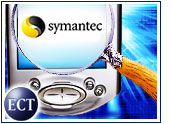
Antivirus giant Symantec is touting features like centralized management and wireless Web updates in its new AntiVirus for Handhelds line that will be available in consumer and corporate versions beginning in September.
Symantec joins other antivirus and security companies, including Network Associates, Trend Micro and Computer Associates, that have aimed their defense against viruses, worms and other malicious code at smaller, handheld devices, such as PDAs.
However, security experts agreed that while mobile antivirus might be a proactive approach, there is little need or demand for such protection among corporations that are still struggling to protect desktop systems from the latest worm attacks.
“There’s no market yet because the problem doesn’t exist in people’s minds yet,” Aberdeen Group research director Eric Hemmendinger told TechNewsWorld. “People are not at the point of recognizing this as a problem that is high priority.”
Vulnerability in Hand
Citing research that indicates 99 percent of handhelds run without antivirus software, Symantec claims that home and enterprise networks are put at risk when they connect with mobile devices that do not have antivirus protection.
Company spokesperson Phil Weiler told TechNewsWorld that while enterprise IT departments have resisted the use of handhelds, the mobile devices have crept into corporate IT culture anyway. Now that companies are recognizing and deploying the devices, they want to make sure they are not opening holes in the corporate network, he said.
However, Gartner research vice president Richard Stiennon told TechNewsWorld that while there are several security issues with handhelds, viruses are not among them.
“The biggest issue is that they are access devices that tie into corporate systems and they get lost,” Stiennon said.
Wireless Web Update
Among the new features offered by Symantec, which will sell AntiVirus for Handhelds for US$40, is LiveUpdate Wireless, which will let users with a wireless Internet connection download virus definitions and update protection over the Internet.
After normal desktop synchronization, the wireless update will give users up-to-date protection through device-specific virus definitions and product updates, Symantec said.
The renewal price of the subscription for AntiVirus for Handhelds — compatible with Palm OS and Microsoft Pocket PC devices — is $20. Symantec will offer the corporate edition of the handheld antivirus on a license-based scale between $10 and $27.
Too Proactive
Stiennon said that Symantec, other antivirus players and even device makers such as Nokia see an opportunity in antivirus even though it might be a case of being proactive. After all, the issue is not big enough to drive users to purchase antivirus software for their handhelds just yet.
“It offers some pretty cool conveniences, but I don’t think there’s a significant market,” he said.
Hemmendinger noted that antivirus vendors want to show they recognize the issue before there is an outbreak among mobile devices, but he said he doubts the products are profitable for the companies and agreed there is no real market for them now.
Low-Power Protection
Stiennon, who said the diversity of handheld platforms provides some shelter from viral attacks, indicated the smaller devices might become more of a target as their operating systems become more powerful.
As a result, Gartner advises handheld manufacturers to use simple, stripped-down systems that leave little room for viruses or other malicious code.
Stiennon also said that to be truly proactive in the fight against viruses, applications and operating systems must be written better to avoid flaws and holes that enable viruses.
“If antivirus on handheld devices is as wonderful as the antivirus vendors think it is, then something’s wrong,” he said. “It should be straightforward to create a device that isn’t susceptible.”





















































